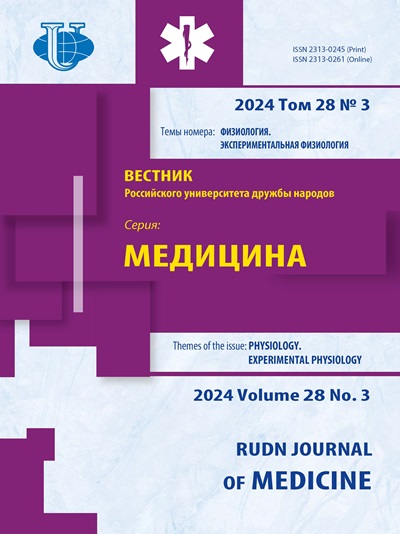Осведомленность современной молодежи о возможности передачи микроорганизмов при поцелуе
- Авторы: Стрельцова Т.А.1, Числова И.А.1
-
Учреждения:
- Санкт-Петербургский государственный университет
- Выпуск: Том 26, № 2 (2022): АНАТОМИЯ И ПАТОЛОГИИ КРУПНЫХ СУСТАВОВ
- Страницы: 180-187
- Раздел: МИКРОБИОЛОГИЯ
- URL: https://journals.rudn.ru/medicine/article/view/31079
- DOI: https://doi.org/10.22363/2313-0245-2022-26-2-180-187
Цитировать
Полный текст
Аннотация
Актуальность. В настоящее время изменились многие представления о проявлении чувств между людьми, но поцелуи до сих пор остаются одной из важнейших форм социальных взаимоотношений. Накопившаяся информация о возбудителях заболеваний, передаваемых при контакте людей в процессе поцелуя, очень велика, но она остается все ещё не достаточно известной широкой аудитории. К сожалению, этой немаловажной теме уделяют недостаточно внимания, как в обществе в целом, так и среди молодежной аудитории. Цель: выявление степени осведомленности современной молодежи о возможности передачи различных микроорганизмов при поцелуях, а также определение актуальности данной проблемы. Материалы и методы. Анализ научной литературы о микроорганизмах, передаваемых при контакте слизистых оболочек ротовой полости. Эмпирический метод - тестирование, в котором приняли участие 140 человек в возрасте от 16 до 25 лет. Анкетирование включало шесть вопросов, позволяющих оценить уровень знаний об инфекционных агентах, передаваемых с поцелуями, а также актуальность данной темы среди молодежи. Результаты и обсуждение. Проведенное анкетирование выявило 97 % опрошенных, которым известно, что при поцелуе возможна передача бактериальной инфекции, при этом 57 % слышали об опасности передачи лишь некоторых микроорганизмов или не знали о них совершенно. Каждый шестой участник опроса (18 %) сталкивался лично или знал от знакомых, что поцелуи стали причиной возникновения у них инфекционных заболеваний. 88 % опрошенных считали, что данная тема плохо освещена в СМИ. Необходимо подчеркнуть, что 91,4 % анкетированных лиц захотели узнать об этой теме подробнее. Вопросом о факторах защиты полости рта и о потенциальных возбудителях заболеваний слизистых оболочек верхних отделов респираторного тракта заинтересовались в среднем 65 % опрошенных, о работе иммунной системы ротовой полости захотели узнать 56,4 % молодых людей. Выводы. Исследование данного вопроса показало, что тема передачи возбудителей бактериальных инфекций при поцелуях весьма актуальна среди молодежи. Доступной для молодежи информации по данной проблеме недостаточно, поскольку в обществе эта тема не получила широкого распространения. Большинство опрошенных хотели бы узнать гораздо подробнее о возможном переносе возбудителей инфекционных заболеваний при поцелуях.
Об авторах
Т. А. Стрельцова
Санкт-Петербургский государственный университет
Email: str.tatia@gmail.com
ORCID iD: 0000-0003-2097-9378
СанктПетербург, Российская Федерация
И. А. Числова
Санкт-Петербургский государственный университет
Автор, ответственный за переписку.
Email: str.tatia@gmail.com
ORCID iD: 0000-0002-2969-8209
СанктПетербург, Российская Федерация
Список литературы
- Hajishengallis G., Chavakis T. Local and systemic mechanisms linking periodontal disease and inflammatory comorbidities // Nat Rev Immunol. 2021. V. 21. № 7. P. 426-440. doi: 10.1038/s41577-020-00488-6.
- Царёв В.Н. Микробиология, вирусология и иммунология. М.: Практическая медицина. 2009. 581 с.
- Ranadheer E., Nayak U.A., Reddy N.V., Rao V.A. The relationship between salivary IgA levels and dental caries in children // J. Indian Soc. Pedod. Prev. Dent. 2011. № 29. P. 106-12.
- Гурьянова С.В., Борисова О.Ю., Колесникова Н.В., Лежава Н.Л., Козлов И.Г., Гудима Г.О. Влияние мурамилпептида на микробный состав микрофлоры ротовой полости // Иммунология. 2019. T. 40. № 6. P. 34-40. doi: 10.24411/0206-4952-2019-16005
- Рыбальченко О.В., Бондаренко В.М., Добрица В.П. Атлас ультраструктуры микробиоты кишечника человека. 2008. СПб. ИИЦ ВМА. 2008. 112 с.
- Бухарин О.В., Валышев А.В., Гильмутдинов Ф.Г. Экология микроорганизмов человека. Екатеринбург. 2006. 125 c.
- Smith A.J., Jackson M.S., Bagg J. The ecology of Staphylococcus species in the oral cavity // J Med Microbiol 2001. V. 50. № 11. P. 940-6.
- Микляев С.В., Леонова О.М., Сущенко А.В., Козлов А.Д., Агаризаев И.Ф., Новиков А.В. Микробиологический пейзаж пародонтального кармана при воспалительных заболеваниях в тканях пародонта // Вестник Российского университета дружбы народов. Серия: Медицина. 2021. Т. 25. № 4. С. 332-338. doi: 10.22363/2313-0245-2021-25-4-332-338
- Левинсон У. Медицинская микробиология и иммунология. М.: БИНОМ. Лаборатория знаний. 2015. 1181с.
- Neal K.R., Nguyen-V an-Tam J.S., Jeffrey N., Slack R.C., Madeley R.J., Ait-T ahar K., Job K., Wale M.C., Ala’Aldeen D.A. Changing carriage rate of Neisseria meningitidis among university students during the first week of term: cross sectional study // BMJ. 2000. V. 320. № 3. P. 846-9. doi: 10.1136/bmj.320.7238.846
- Brumfield W.A., Smith D.C. Transmission sequence of syphilis // Am J Public Health Nations Health 1934. V. 24(6 Pt 1). P. 576-80.
- Murrell M., Gray M. Acquired syphilis in children // Br Med J. 1947. V. 4518. № 2. P. 206-207.
- Smith Jr.F. Acquired syphilis in children. An epidemiologic and clinical study // Am J Syphilis 1939. V. 23. P. 165-85.
- Holani A.G., Ganvir S.M., Shah N.N., Bansode S.C., Shende I., Jawade R., Bijjargi S.C. Demonstration of Mycobacterium tuberculosis in sputum and saliva smears of tuberculosis patients using Ziehl Neelsen and flurochrome staining - a comparative study // J Clin Diagn Res. 2014. V. 8. № 7. P. ZC425. doi: 10.7860/JCDR/2014/9764.4587
- Gonzalez Mediero G., Vazquez Gallardo R., Perez Del Molino M.L., Diz Dios P. Evaluation of two commercial nucleic acid amplification kits for detecting Mycobacterium tuberculosis in saliva samples // Oral Dis. 2015. V. 21. № 4. P. 451-5. doi: 10.1111/odi.12302
- Eguchi J., Ishihara K., Watanabe A., Fukumoto Y., Okuda K. PCR method is essential for detecting Mycobacterium tuberculosis in oral cavity samples // Oral Microbiol Immunol. 2003. V. 18. № 3. P. 156-9. doi: 10.1034/j.1399-302x.2003.00050.x
















